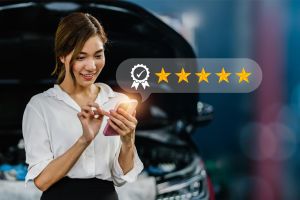Optimizing sales results, maximizing lead conversion and driving sales leads are the three cornerstones that collision repair businesses should consider in their marketing strategy, Advanced Digital Media Services (ADMS) CEO Paul Donahue said during a webinar Jan. 15.
Those are the main pieces of an accelerated growth model that ADMS has constructed based on interactions with more than 250 repair shop owners over a 15-year period, that the company regularly advises its clients to follow.
Donahue’s input, provided during an Automotive Service Association (ASA) webinar, comes as the collision repair industry and automotive industry writ large are undergoing rapid technological transformation. For instance, repair shops have recently obtained the services of automation platforms to aggregate customers’ online reviews and expedite their responses, and are increasingly using artificial intelligence to streamline damage estimates and subrogation claim verifications.
Automation will likely be the biggest marketing-related driver of repair sales in 2025, and can help shops optimize their sales results, with local service ads (LSAs) providing the best return on investment (ROI), Donahue said. LSAs, which have only been launched in California and Florida so far, involve a tag designation of “Google Guaranteed” when a consumer searches for a particular type of business on a search engine.
“If we have anybody in here on this [webinar] that's in Florida or California, your digital marketing agency, if you're doing paid ads, should have already informed you of this a long time ago,” Donahue said. “Please look into it if you're in those two states.”
Another key piece of results optimization is determining overall ROI, he noted, adding that shops should correlate dollars invested with the amount of revenue received on booked jobs.
Shops can measure ROI through online reporting, shop management programs, customer relationship management (CRM) platforms, or all three, Donahue said.
Conversion maximization is another important pillar of collision repair shops’ marketing strategy, as about 20% to 60% of today’s overall website traffic isn’t converted into sales, according to Donahue.
“When we hand things off to a marketing agency, all we’ll think about is leads,” he said. “But the reality is the money's made in the conversion of those leads to booked jobs, and it's really made in the conversion of those booked jobs into higher tickets.”
Quickly responding to Google, CARFAX and Yelp ratings can help shops solidify their reputations and raise conversions, Donahue said.
“Before they visit your business…they'll take a look at your Google ratings; they'll look at your CARFAX ratings; Yelp; and, they'll check you out,” he added. “If you don't have any reviews, which is as bad as not having any current reviews, that's important. Reviews need to be current; you need to be responding to them as much as possible.”
In addition to organic search engine optimization and paid searches, working your customer database and remarketing to them via text or email is a key prong of the driving leads pillar of ADMS’s accelerated growth model.
Tapping into the database is a low-cost way shops can quickly drive leads, Donahue said.
“Send out those offers each and every month to your current client base,” he said. “Even if they don't like the offer, it doesn't matter. It helps you stay top of mind with them, and when they start hearing a noise coming from their brakes, the first person they'll think about is you, because you're the person that's constantly staying in touch with them.”














Brian Bradley